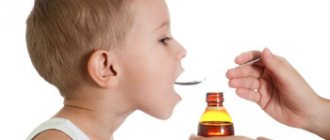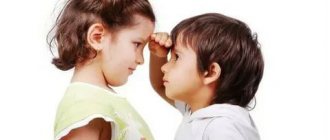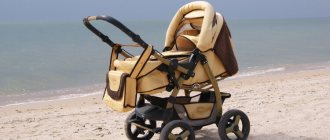For an adult, a slight increase in temperature, runny nose and cough are common.
But what to do if an infant has a cold? How can I help him cope with the disease more easily? Is it possible to give him medication and how can I protect him from developing complications? Acute respiratory viral infection (ARVI) is one of the most pressing problems in medicine, especially in pediatrics. Even in non-epidemic years, the registered incidence of ARVI is many times higher than the incidence of all major infectious diseases. And during pandemics, more than 30% of the world's population is involved in the epidemic process, and more than half of them are children. And although the highest incidence rate is observed in preschoolers and primary schoolchildren, newborn children are also not protected from viruses.
Of course, babies receive antibodies from their mother’s milk, which at first help protect the baby’s body from various infections. However, newborn children are at risk for developing ARVI and influenza, since their immune system has not yet been functionally formed. Therefore, the risk of complications when a baby has a cold increases significantly due to the imperfect functioning of the body’s defenses.
The danger of a cold for an infant
When pathogens of acute respiratory infections enter the mucous membrane of the respiratory tract, they cause inflammation. This leads to a runny nose, cough and fever. Immunity weakened by viruses can lead to bacterial infections. In this case, inflammation can spread to other parts of the respiratory tract: the middle ear (otitis), sinuses (sinusitis and sinusitis), bronchi (bronchitis) and lungs (pneumonia). In such situations, they talk about bacterial complications, and therefore aggravation of the infectious process.
ARVI in newborns can also lead to the appearance of ulcerations on the oral mucosa, which will create difficulties when feeding the child. But the most severe complications of a viral infection are meningitis, encephalitis or meningoencephalitis, which affects the brain. These conditions require immediate medical attention. If your baby cries monotonously for a long time, constantly tries to throw his head back, while his consciousness is impaired - do not hesitate, immediately seek help from specialists. Colds without fever in children also require the attention of parents and doctors.
How does influenza occur in newborns?
Most often, influenza in children of this age category is caused by influenza B and A2 viruses. The disease is characterized by a gradual accumulation of symptoms. The temperature rises immediately and slightly; the symptoms that are pronounced in adults during the flu may be completely absent in newborns. There may be some pallor of the skin, poor appetite, slight cough, wheezing, vomiting, and nasal congestion. The picture of the manifestations of influenza is rather weakly expressed, but despite this, the disease itself is very difficult, and in many cases complications may arise in the form of an associated bacterial infection, which ends in pneumonia or otitis media.
What to do if your baby has a cold
The treatment of acute respiratory viral infections in newborns should have an integrated approach, which includes improving the child’s nasal breathing, controlling body temperature, combating toxicosis, and also influencing the causative agents of the disease.
The main symptoms of a cold in infants are:
- nasal congestion and excessive discharge,
- increase in body temperature,
- lethargy,
- poor appetite
- sleep disturbance,
- anxiety,
- disruption of the gastrointestinal tract,
- cough,
- sore throat and breathing problems.
Each of these signs can manifest itself to varying degrees. Very young children do not know how to sneeze and cough, nor do they know how to blow their nose on their own. If the baby has a cold, parents need to regularly clean the baby's nose using an aspirator in the form of a bulb, tube or electronic device. This will not only make breathing easier, but also reduce the risk of complications, infection in the throat, bronchi, and improve the baby’s well-being. The main thing is to clean the newborn’s nose as carefully as possible so as not to damage the delicate mucous membrane.
If a child has ARVI, wet clean the children's room every day and ventilate it more often. In the cold season, it is better to postpone walks until the main symptoms of the disease disappear; water procedures should also be kept to a minimum - wash the baby in the shower as soon as it gets dirty. In the room of a cold baby, the temperature should be no higher than 220C, and the humidity should be no less than 60%.
Don't try to force-feed children if they don't want to, but you should give them something to drink more often. It is better if it is plain water without added sugar.
Do not mindlessly follow traditional medicine recipes and try to instill breast milk into your child’s nose. It is an excellent breeding ground for germs and can lead to additional health problems. If necessary, you can rinse your baby's nasal passages and use drops with an antiseptic or vasoconstrictor effect, which the pediatrician will recommend.
If the body temperature rises above 380C, the child should be given an antipyretic drug, also after consulting with a doctor. Under no circumstances should you rub your baby’s body with vinegar or alcohol – substances easily penetrate the body through enlarged skin pores and can cause irreparable harm to the baby. To alleviate the child’s condition, you can wipe his legs, arms, tummy, and neck with plain warm water.
Antiviral drugs will help speed up the recovery process and can also be used to prevent ARVI. The main task of parents is to select medications that can be used to treat and prevent colds in newborns. One of these drugs is the antiviral drug VIFERON, which has a wide spectrum of antiviral activity. Alpha-2b interferon, which is part of the drug, was created on the basis of modern technologies. Antiviral properties allow it to block the reproduction of the virus, and the immunomodulatory effect helps restore immunity. VIFERON preparations were developed as a result of fundamental research in the field of immunology, which proved that in the presence of antioxidants (vitamins C, E and others), the antiviral effect of interferon is enhanced.
The drug VIFERON Candles (suppositories) can be used to treat children from the first days of life. Premature newborns with a gestational age of less than 34 weeks are prescribed Viferon 150,000 IU, 1 suppository 3 times a day after 8 hours every day for 5 days. According to clinical indications, therapy can be continued. The break between courses is 5 days.
Children under 7 years old, incl. newborns and premature infants with a gestational age of more than 34 weeks are prescribed VIFERON Suppositories (suppositories) 150,000 IU, 1 suppository 2 times a day after 12 hours every day for 5 days. According to clinical indications, therapy can be continued. The break between courses is 5 days.
You can also use VIFERON Gel to combat acute respiratory infections. This drug can also be used to treat children from the first days of life. It is necessary to apply a strip of gel approximately 0.5 cm long to the nasal mucosa 3-5 times a day for 5 days. Before this, it is better to rinse the mucous membrane with saline solution. In order to protect a child from ARVI, it is necessary to apply a strip of gel approximately 0.5 cm long to the nasal mucosa 2 times a day as a preventive measure. Course duration is 2-4 weeks.
“Parent meeting” - or task for adults
During the season of spreading viruses, the child’s body undergoes a serious test of resistance. Poor nutrition, a sedentary lifestyle, and an unstable child’s daily routine – all this increases the risk of the disease.
Provide the child’s body with a “comfortable regime”:
- Avoid visiting crowded places with your child (public transport, shopping centers, cinema, swimming pool, etc.) If necessary, use disposable masks, changing them at least once every two hours.
- Ventilate the rooms in which the child is located, maintain optimal temperature and humidity, carry out wet cleaning, wash toys and other objects with which the child interacts outside the home.
- Moisturize your child's nasal mucosa with special oils—this will create a barrier to infection.
- Rinse your child's nose with seawater irrigation therapy before bed.
- Walk with your children outdoors more often, avoiding hypothermia. Don't forget to take water on your walks so that children can drink at any time.
- Provide your child with adequate nutrition, thereby increasing the child’s body’s resistance to viruses. Food should be rich in vitamins and microelements.
- For additional support, special safe medications are suitable. For example, taking Oscillococcinum prophylactically once a week reduces the risk of developing ARVI by three times[2].
Prevention of colds in infants
From the second month of life, the child will benefit from hardening, which in the future will help protect him from colds. And in order for the baby not to catch a cold during epidemics, it is necessary to follow the rules of caring for a newborn and not forget about preventive measures. It is worth limiting family visits to strangers in the first three months of life, especially in the autumn-winter period. Do not allow your child to become hypothermic, but also beware of overheating; dress him according to the weather. Be sure to keep your newborn’s items clean, periodically sterilize them, and don’t forget to wash your hands when you come home from the street.
If someone in the house where the baby lives is sick, it is necessary to limit their contact with the baby as much as possible. If a mother gets sick with the flu, the issue of continuing breastfeeding should be discussed with her doctor. If possible, it is better not to refuse feeding, because mother's milk is the best nutrition for newborns and children in the first year of life. When feeding and changing a child, a sick mother should remember to wear a mask and change it more often.
Reference and information material
Author of the article
Belyaev Dmitry Alexandrovich
General doctor
Loading...
Take other surveys
Memo for parents on the prevention of ARVI and influenza in children
In order to ensure seasonal prevention of ARVI and influenza, the following measures must be taken:
Ensuring compliance with personal hygiene rules, including:
- maintaining a daily routine (sufficient sleep, walks in the fresh air, avoiding physical and mental overload);
- avoid both hypothermia and overheating of children, especially younger ones;
- wash your hands regularly and thoroughly with soap;
- use individual or disposable towels;
- Cover your mouth and nose with disposable tissues when coughing and sneezing.
Carrying out regular ventilation and wet cleaning of the room in which the child is located and the apartment as a whole. Carrying out hardening measures (pouring feet with water at room temperature at night; for young children - staying without clothes at room temperature in the absence of drafts for several minutes before feeding). Carrying out nonspecific prevention of colds (using drugs arbidol, ascorbic acid, anaferon, etc. (in accordance with the instructions for use, in the absence of contraindications). AT THE FIRST SIGNS OF THE DISEASE:
- isolate the child from other children (family members);
- call a doctor;
- exclude the child from staying in an organized group.
REMINDER FOR PARENTS.
Influenza, caused by a constantly changing virus, occurs as a respiratory disease, transmitted from person to person mainly through airborne droplets, as well as through the hands with which we cover our nose and mouth when sneezing and coughing. Most people in the world infected with this virus become ill in a mild to moderately severe form, but severe cases of the disease with a fatal outcome have also been reported.
What are the symptoms of the disease?
Flu symptoms: fever, cough, sore throat, body aches, headache, chills and fatigue, and rarely vomiting and diarrhea
Features of the flu
In adults, the disease usually begins suddenly with a sharp rise in temperature, headache, muscle and joint pain. In children, the flu progresses differently: some become lethargic, sleep a lot, others become restless, irritable, the temperature rises to 37 - 38 degrees, and there is difficulty breathing.
THE FLU VIRUS IS CONTAGIOUS!
It is known that a patient with influenza can be contagious from 1 day before the first symptoms of the disease appear and up to 7 days after the onset of the disease. To prevent the spread of the influenza virus, you must:
- get vaccinated against influenza, since the vaccine is the most effective means of prevention;
- carry out wet cleaning of premises using disinfectants;
- regularly ventilate the room;
- Teach children to wash their hands frequently with soap and water for 20 seconds. Parents should also follow this procedure, which will serve as a good example for children.
- Teach children to cough and sneeze into a tissue or hand. Parents should also follow this procedure, which will serve as a good example for children. Teach children not to approach patients closer than one and a half to two meters;
- Sick children should stay at home (not attend preschool and educational institutions).
- refrain from visiting crowded places.
In case of all the above symptoms in a child: fever, cough, sore throat, chills, headache, difficulty breathing, pain in muscles and joints, rash, vomiting, diarrhea, parents are obliged to immediately seek help from a doctor.
REMINDER for parents on the prevention of ARVI and influenza in children
Treating ARVI: common mistakes of parents
When children suffer from ARVI, and every family faces such a scourge, parents often become “home pediatricians” who recognize the symptoms of a cold and know treatment regimens. However, without knowing it, many mothers and grandmothers make the same mistakes, which prolong the disease process, preventing a quick recovery.
Mistake #1: Not getting fresh air
We are used to automatically closing windows and vents in the house as soon as the child shows the first signs of a cold. Of course, a sick baby should not be overcooled. But staying in an unventilated room for a long time, especially if the central heating is on, can cause no less harm. Harmful microorganisms and viruses thrive in a dry and warm environment. Therefore, parents should ventilate rooms more often; clean, cold air reduces the concentration and activity of viruses. At the moment of ventilation, simply take the child to another room, and return when the fresh air has time to warm up.
Mistake #2: Force feeding
Decreased appetite is an absolutely normal reaction of the body to illness. This is due to the fact that its forces are aimed at fighting infection, and digesting food can create additional stress. In addition, a child with a cold moves little and, accordingly, spends less energy. Be understanding of your child’s reluctance to have a full lunch and dinner. Reduce portions and make the menu light during treatment and recovery.
Mistake #3: Strict bed rest
If your child is seriously ill and suffers from fever and weakness, you will probably not have to put him to bed for long. But if the baby does not have a high temperature, and he feels relatively cheerful, there is no point in forcing him to spend the whole day in bed. On the contrary, moderate physical activity helps the child take his mind off the illness. While the need for complete peace intensifies the situation.
Mistake #4: Trying to lower the temperature
It is no secret that elevated body temperature indicates the body’s fight against the virus. Antipyretics are recommended to be taken when the temperature rises to a dangerous level, that is, above 38.5°. But up to this point, taking medications is most often not required.
Mistake #5: Wrapping up a child with a fever
We have learned well our grandmother’s lesson about how to “sweat” when the temperature is high. That's why many of us wrap our baby up at night in warm clothes and a few blankets. But in fact, a baby should not be overheated during a fever, as this disrupts thermoregulation processes and worsens the situation. The child should not wear a lot of clothes, and all of it should be loose, made of natural fabrics.
Mistake #6: Unauthorized choice of antibiotics
Some parents are accustomed to “prescribing” antibiotics to their child at the first sign of ARVI. This is absolutely impossible to do. Antibacterial drugs should only be prescribed by the attending physician. Otherwise, antibiotics can cause damage to the child’s body, weakening it by destroying the natural intestinal microflora. In addition, self-administration of antibiotics often changes the symptoms of the ongoing disease, which subsequently only complicates the diagnosis and complicates treatment.
Pediatrician at OKDC Anna Pogorelova
share information
0
Social buttons for Joomla
ARVI in children: when you urgently need a doctor
In the state of a sick child, several zones are conventionally distinguished: green, yellow and red (by analogy with a traffic light). When children have a cold, they can be in the safe “green zone” even at high temperatures (up to 41°C, if they do not have severe neurological disorders or heart defects), because fever is a tool in the fight against viruses, it does not in itself carries threats. However, there are “red flags” that every parent should be able to recognize in time. 1. The child is lethargic and wants to sleep all the time.
The first thing parents should pay attention to is that the child has become less active. The usually smiling, running, playing baby suddenly became lethargic. He is not interested in what is happening around him, wakes up only after you wake him up, immediately falls asleep again or does not wake up at all. 2. Change in skin color
If the skin is pale, this is a reason to show the child to the doctor. When it is bright red, mottled or ash-gray, this is a signal to immediately consult a pediatrician. 3. Rapid breathing
A “crackling” sound is heard in the child’s chest and he “grunts.” The respiratory rate in children 6-12 months exceeds 50 breaths per minute, in children older than one year - 40 breaths per minute. If these symptoms occur, call an ambulance.
4. Tachycardia
Heart rate increases. A child under one year old has more than 160 beats per minute, 1-2 years old - more than 150 beats per minute, 2-5 years old - more than 140 beats per minute. 5. Signs of dehydration
Even at high temperatures, the child’s skin may be of normal color, and the mucous membranes may be moist. This means that the fluid that he loses through sweat, breathing and urination is replenished.
If this does not happen, the child’s lips and mucous membranes will be dry, and the frequency of urination will decrease (less than once every 4 hours). He will refuse liquids or be unable to swallow them. Breasts will suck sluggishly and little.
If dehydration is suspected, the time of skin fold expansion should be checked. Use your thumb and forefinger to grab the skin on your stomach to the side of your navel. Then unclench your fingers: if the skin fold straightens for more than 3 seconds, show the child to the doctor. If it does not straighten out for more than 5 seconds, call an ambulance. 6. Ear discharge
Any fluid leaking from the ears - pus or bloody discharge - is most likely a sign of a perforated eardrum, which requires urgent examination.
7. Chills, vomiting and other symptoms
Quite often, with mild viral infections, parents do not consult a doctor. However, remember that the child must be examined by a doctor if he has the following symptoms.
Temperature above 39°C in a child 3-6 months old: fever lasts more than 5 days; chills – a feeling of cold, which is accompanied by muscle tremors; severe swelling/edema of the limbs or joints; weakness in an arm or leg.
Call an ambulance immediately: if the temperature is above 38°C in a child under 3 months; the rash does not turn pale when pressed; vomiting like a fountain; the neck is motionless/photophobia has appeared; bloody stools; abdominal pain, especially in the right half; swelling or hyperemia of the scrotum; unexplained persistent weight loss; increased constant sweating for more than 6 weeks; persistent epileptic seizures; neurological symptoms appeared: facial distortion, speech impairment, impaired motor coordination, recurring headaches, the child does not use one or more limbs in play/life activities.










